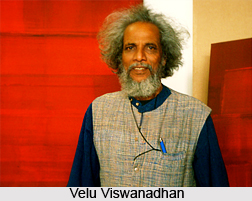 Velu Viswanadhan was born at Kadavoor in Kollam district in Kerala. After being expelled from the Sree Narayana College of Art, Quilon for political activity in 1959 he joined the Madras School of Arts in 1960. Here he studied under the well-known painter KCS Paniker. In 1966, he helped in the formation of the Chola Mandal Artists` Village.
Velu Viswanadhan was born at Kadavoor in Kollam district in Kerala. After being expelled from the Sree Narayana College of Art, Quilon for political activity in 1959 he joined the Madras School of Arts in 1960. Here he studied under the well-known painter KCS Paniker. In 1966, he helped in the formation of the Chola Mandal Artists` Village.
He looks at his work as an individual journey and an exploration. His initial works are figurative however later he evolved to experiment with abstract and geometric forms. In the late 1960s he was inspired by geometrical ritualistic-magical diagrams of Kerala and explored the visual language inbuilt in them. These theme returns in his work time with gradual evolution of form and colour.
He innovated with styles, sometimes mixing watercolours and oils as a result of which transparency of one medium blends into the dullness of the other. In his work of the 1970s he even used gold and silver colours. He uses strong hand made paper and these works combine a technique which is utilized in making handcrafts with a sophisticated sense of business. Works of later stage show usage of Indian ink to create large, horizontal formats and smaller square drawings.
He works mostly on paper, canvas and metal plate. Limited space prompted him to use small formats in his work. He draws with an arresting technique. The outline is drawn with thick stamping ink an outline is drawn. Thereafter oil paint is applied with a brush and an essence of turpentine is applied to it. The transparent and thin paint reveals the geometric forms. Viswanadhan has made a series of films based on the primary elements of Nature like sand, water, fire, air and ether. Viswanadhan treads a path of self-discovery in his creations.
Viswanadhan`s latest solo show was held in New York at the Marlborough Gallery in 2008. He has also exhibited solo several times at Galerie Darthea Speyer, Paris, since his first solo show at the gallery in 1982. In 1985, his `Sand / Water` exhibition was held at the Centre Georges Pompidou, Paris. Within India, Viswanadhan has had solo shows at Jehangir Art Gallery, Tao Art Gallery, and Gallery Chemould in Mumbai, as well as the National Gallery of Modern Art (NGMA) and Vadehra Art Gallery in New Delhi, among others. Among the many awards to his credit, in 2005, he was awarded the Chevalier des Arts et Letters by the Government of France.



















